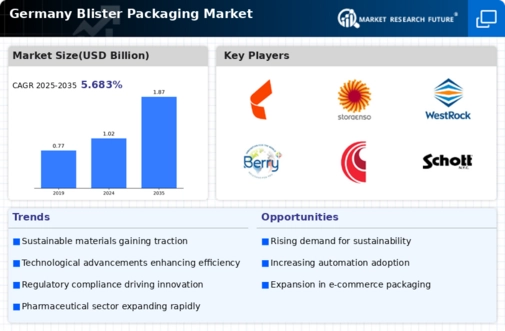Consumer Preference for Convenience
In Germany, the blister packaging market is significantly influenced by changing consumer preferences. These preferences lean towards convenience and ease of use. As lifestyles become busier, consumers are gravitating towards products that offer quick access and portability. This trend is particularly evident in the food and beverage sector. Blister packaging provides single-serving options that enhance convenience. In 2025, it is estimated that the food sector will account for around 25% of the blister packaging market. The ability to provide portion control and reduce food waste aligns with consumer demands for sustainability, further driving the adoption of blister packaging solutions. Consequently, manufacturers are focusing on developing user-friendly designs that cater to these evolving consumer needs.
Technological Innovations in Packaging
Technological advancements are playing a crucial role in shaping the blister packaging market in Germany. Innovations such as smart packaging, which incorporates QR codes and NFC technology, are becoming increasingly prevalent. These technologies enhance consumer engagement and provide valuable information regarding product usage and safety. In 2025, it is projected that the integration of technology in packaging will account for approximately 20% of the blister packaging market. This shift towards smart packaging solutions not only improves the user experience but also allows manufacturers to differentiate their products in a competitive market. As consumers become more tech-savvy, the demand for innovative blister packaging solutions that incorporate these technologies is likely to rise, further propelling market growth.
Rising Demand for Pharmaceutical Products
The blister packaging market in Germany is experiencing a notable increase in demand. This demand is driven by the pharmaceutical sector. With the country's robust healthcare system and a growing population, the need for efficient and secure packaging solutions is paramount. In 2025, the pharmaceutical industry is projected to contribute approximately 30% to the overall blister packaging market. This growth is attributed to the rising prevalence of chronic diseases and the subsequent demand for medication adherence solutions. Blister packaging offers advantages such as dosage accuracy and protection against environmental factors, which are crucial for maintaining the integrity of pharmaceutical products. As a result, manufacturers are increasingly investing in innovative blister packaging technologies to cater to this expanding market segment.
Sustainability and Eco-Friendly Materials
The blister packaging market in Germany is witnessing a shift towards sustainability. The use of eco-friendly materials is also increasing. As environmental concerns become more pronounced, consumers and businesses alike are prioritizing sustainable packaging solutions. In 2025, it is estimated that eco-friendly materials will constitute around 18% of the blister packaging market. This trend is driven by increasing regulations aimed at reducing plastic waste and promoting recyclable materials. Manufacturers are responding by exploring biodegradable and recyclable options that align with consumer preferences for sustainability. The adoption of such materials not only meets regulatory requirements but also enhances brand reputation, making it a key driver in the blister packaging market. As companies strive to improve their environmental footprint, the demand for sustainable blister packaging solutions is expected to grow.
Regulatory Compliance and Safety Standards
The blister packaging market in Germany is heavily influenced by stringent regulatory compliance. Safety standards also play a significant role. The pharmaceutical and food industries are particularly affected, as they must adhere to rigorous guidelines to ensure product safety and quality. In 2025, it is anticipated that compliance-related costs will represent a significant portion of the overall packaging expenses. These costs could potentially reach 15% of the market. This necessitates the use of advanced blister packaging solutions that meet these regulations while maintaining product integrity. Manufacturers are thus compelled to innovate and invest in materials and technologies that not only comply with safety standards but also enhance the overall consumer experience. This focus on compliance is likely to drive growth in the blister packaging market as companies seek to avoid penalties and ensure consumer trust.



















Leave a Comment